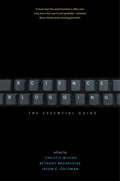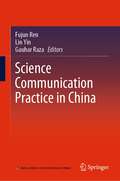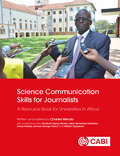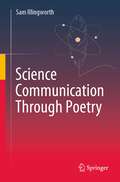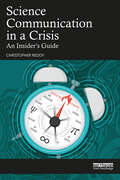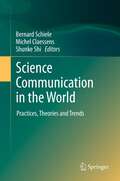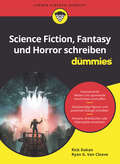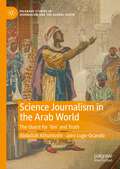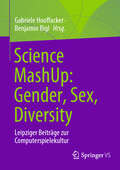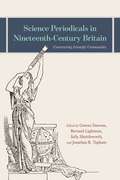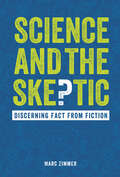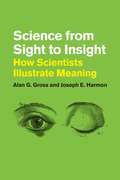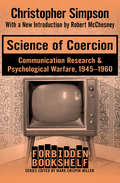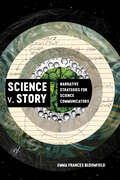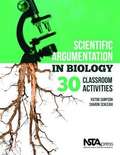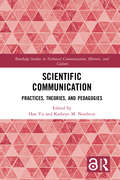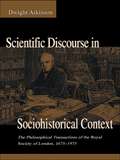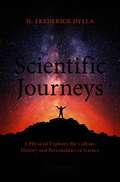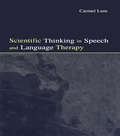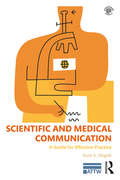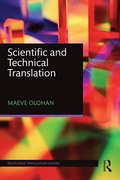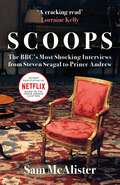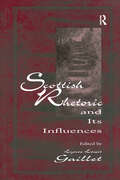- Table View
- List View
Schreiben und Redigieren – auf den Punkt gebracht: Das Schreibtraining für Kommunikationsprofis und Corporate Writer
by Ivo Hajnal Franco ItemDas Buch bietet professionellen Schreiberinnen und Schreibern praxisnahe Anregungen, eigene wie fremde Texte zu optimieren. Ein professioneller Sprachgebrauch hält sich an klare, objektive Vorgaben. Dementsprechend beruht dieses Buch auf empirischen Daten zur Verständlichkeit von Unternehmens- und Medientexten, die in eine leicht umzusetzende Checkliste münden.
Science Blogging
by Bethany Brookshire Christie Wilcox Jason G. GoldmanHere is the essential how-to guide for communicating scientific research and discoveries online, ideal for journalists, researchers, and public information officers looking to reach a wide lay audience. Drawing on the cumulative experience of twenty-seven of the greatest minds in scientific communication, this invaluable handbook targets the specific questions and concerns of the scientific community, offering help in a wide range of digital areas, including blogging, creating podcasts, tweeting, and more. With step-by-step guidance and one-stop expertise, this is the book every scientist, science writer, and practitioner needs to approach the Wild West of the Web with knowledge and confidence.
Science Communication Practice in China
by Fujun Ren Lin Yin Gauhar RazaChina has made remarkable and rapid progress in the area of science communication, both in theory and practice. This book critically examines all aspects of science communication practices in China. Dealing with major turning points since the introduction of the ‘Science and Technology Popularization Law’ and the ‘Outline of the National Scheme for Scientific Literacy’, the book tells a success story by scrutinizing structural changes in science communication policies, education system, construction and efficacious utilisation of science popularisation facilities, and creative use of a mix of traditional and modern channels of communication. The book also gives an in-depth analysis of the monitoring and evaluation mechanism, which constitutes the backbone of the national science communication project. The historical roots of science communication in China include shifts in methodologies, policy instruments, effectual approaches and resultant practices since the days of initial efforts to popularise modern scientific ideas. However, the primary focus of the book remains on the initiatives launched at the turn of the present century. Without losing sight of the national dimensions, each chapter of the book draws from provincial as well as grassroots level experiences. Quantitative and qualitative methods have been used to analyse strengths, weaknesses, hurdles and the efficacy of corrective measures. This book offers a remarkable insight to anyone who is interested in probing the causal relationship between science communication and China’s transformation into a modern society. The primary objective of the book is to analyse the nature of ‘science communication with Chinese characteristics’ and the specificity of the socio-cultural environment in which Science and Technology is located. Though the book is of particular interest to scholars, researchers, students and practitioners of science communication, the narrative style makes it accessible to the general reader who is interested in science-society relationship.
Science Communication Skills for Journalists: A Resource Book for Universities in Africa
by Charles WendoThis book has an introduction and 22 other chapters that cover science communication skills. The editor has detailed knowledge of the field and consultation with leading editors and journalists in the region. It provides hands-on guidance together with examples, learning activities, graded and ungraded quizzes to facilitate learning. The content has been tried and tested by lecturers at two universities in Nigeria and Uganda, who used it to successfully train thousands of students in science communication. Each chapter carries hands-on advice on the practice of science journalism, with learning activities to deepen the learner's understanding of the topic. The book also includes five academic systematic review papers, written by university faculty, that that identify, review and synthesize available literature and experiences on science journalism and communication issues in the region. It also includes a case study detailing the experience of Uganda's Makerere University in introducing science journalism and communication into their undergraduate and post-graduate curricula.
Science Communication Through Poetry
by Sam IllingworthScience Communication Through Poetry aims to explore how we might communicate science effectively both to and with non-scientific audiences across the spectrum of science communication, from dissemination to dialogue, via the medium of poetry. It has been written for scientists, science communicators, public engagement practitioners, and poets, so that they can learn how to use poetry as an effective tool through which to diversify science. As well as containing specific advice and guidance for how to use poetry to communicate science with different audiences, this book contains a number of exercises for the reader to reflect on what has been learnt and to put into practice what is discussed. Further study and additional readings are also provided to help improve knowledge, understanding, and familiarity with both poetry and science communication.
Science Communication in a Crisis: An Insider's Guide
by Christopher ReddyScience Communication in a Crisis: An Insider’s Guide identifies the principal challenges that scientists face when communicating with different stakeholder groups and offers advice on how to navigate the maze of competing interests and deliver actionable science when the clock is ticking. If a scientist’s goal is to deliver content and expertise to the people who need it, then other stakeholder groups—the media, the government, industry—need to be considered as partners to collaborate with in order to solve problems. Written by established scientist Christopher Reddy, who has been on the front lines of several environmental crisis events, the book highlights ten specific challenges and reflects on mistakes made and lessons learned. Reddy’s aim is not to teach scientists how to ace an interview or craft a soundbite, rather, through exploring several high-profile case studies, including the North Cape oil spill, Deepwater Horizon, and the 2021 Sri Lanka shipping disaster, he presents a clear pathway to effective and collaborative communication. This book will be a great resource for junior and established scientists who want to make an impact, as well as students in courses such as environmental and science communication.
Science Communication in the World
by Michel Claessens Shunke Shi Bernard SchieleThis volume is aimed at all those who wonder about the mechanisms and effects of the disclosure of knowledge. Whether they have a professional interest in understanding these processes generally, or they wish to conduct targeted investigations in the PCST field, it will be useful to anyone involved in science communication, including researchers, academics, students, journalists, science museum staff, scientists high public profiles, and information officers in scientific institutions.
Science Fiction, Fantasy und Horror schreiben für Dummies (Für Dummies)
by Rick Dakan Ryan G. Van CleaveSie spielen schon lange mit dem Gedanken, ein Science-Fiction-, Fantasy- oder Horrorwerk zu schreiben, aber Sie wissen nicht, wie Sie es angehen sollen? Oder Sie sind vielleicht schon mitten im Schreibprozess, aber kommen nicht weiter? Dieses Buch liefert Ihnen alle Basics, die Sie brauchen, um faszinierende Welten und packende Charaktere zu erschaffen. Lernen Sie Strategien, um Geschichten aus verschiedenen Genres zu schreiben, zum Beispiel Romane, Kurzgeschichten, Videospiele oder Drehbücher. Anschließend geht es um das spezifische Handwerkszeug für Science-Fiction-, Fantasy- und Horrortexte. Zu guter Letzt geben Ihnen die Autoren auch Tipps, wie Sie Ihr Buch lektorieren, einen Agenten finden oder Ihr Buch per Self-Publishing auf den Markt bringen. So wird aus Ihnen vielleicht bald der nächste Tolkien, King oder Asimov!
Science Journalism in the Arab World: The Quest for ‘Ilm’ and Truth (Palgrave Studies in Journalism and the Global South)
by Jairo Lugo-Ocando Abdullah AlhuntushiThis book examines the main issues and challenges that science journalism faces in the MENA region while analyzing how journalists in these countries cover science and engage with scientists. Most countries in the Middle East and North Africa region have set an ambitious goal for 2030: to transform their societies and become knowledge economies. This means modernizing institutions and encouraging people to embrace Science, Technology, Engineering and Mathematics as part of their daily lives. This books claims that the main vehicle to achieve this goal is science news reporting, as it continues to be the main platform to disseminate scientific knowledge to the general public. Simultaneously, it is also poorly equipped to achieve this task. Interviewing dozens of journalists, the authors looked at specific areas such as the gender divide and its effects on science news reporting as well as the role of religion and culture in shaping journalism as a political institution. The authors conclude that traditional normative assumptions as to why science reporting does not live up to expectations need to be reviewed in light of other more structural problems such as lack of skills and specialization in science communication in the region. In so doing, the book sets out to understand the past, present and future of science news in one of the most challenging regions in the world for journalists.
Science MashUp: Leipziger Beiträge zur Computerspielekultur
by Gabriele Hooffacker Benjamin BiglDas diesjährige Motto – Gender, Sex, Diversity – der vierten Ausgabe der Reihe Science MashUp greift aktuelle politische und gesellschaftliche Debatten ebenso auf wie inhaltliche und technische Entwicklungen im Games-Bereich. Der Band fasst die Tagung im Rahmen der 17. Langen Nacht der Computerspiele sowie weitere Abschlussarbeiten an der Hochschule für Technik, Wirtschaft und Kultur Leipzig (HTWK Leipzig) zusammen. Themen sind die Darstellung und das Identifikationspotenzial von Held*innen in Games, feministisches und barrierearmes Design von Games, inhaltliche und konzeptionelle Analysen von Geschlechter- und Beziehungsrollen in Games, Intersektionalität in Games sowie Grenzüberschreitungen von und mit Games.
Science Periodicals in Nineteenth-Century Britain: Constructing Scientific Communities
by Sally Shuttleworth Bernard Lightman Gowan Dawson Jonathan R. TophamPeriodicals played a vital role in the developments in science and medicine that transformed nineteenth-century Britain. Proliferating from a mere handful to many hundreds of titles, they catered to audiences ranging from gentlemanly members of metropolitan societies to working-class participants in local natural history clubs. In addition to disseminating authorized scientific discovery, they fostered a sense of collective identity among their geographically dispersed and often socially disparate readers by facilitating the reciprocal interchange of ideas and information. As such, they offer privileged access into the workings of scientific communities in the period. The essays in this volume set the historical exploration of the scientific and medical periodicals of the era on a new footing, examining their precise function and role in the making of nineteenth-century science and enhancing our vision of the shifting communities and practices of science in the period. This radical rethinking of the scientific journal offers a new approach to the reconfiguration of the sciences in nineteenth-century Britain and sheds instructive light on contemporary debates about the purpose, practices, and price of scientific journals.
Science Periodicals in Nineteenth-Century Britain: Constructing Scientific Communities
by Sally Shuttleworth Bernard Lightman Gowan Dawson Jonathan R. TophamPeriodicals played a vital role in the developments in science and medicine that transformed nineteenth-century Britain. Proliferating from a mere handful to many hundreds of titles, they catered to audiences ranging from gentlemanly members of metropolitan societies to working-class participants in local natural history clubs. In addition to disseminating authorized scientific discovery, they fostered a sense of collective identity among their geographically dispersed and often socially disparate readers by facilitating the reciprocal interchange of ideas and information. As such, they offer privileged access into the workings of scientific communities in the period. The essays in this volume set the historical exploration of the scientific and medical periodicals of the era on a new footing, examining their precise function and role in the making of nineteenth-century science and enhancing our vision of the shifting communities and practices of science in the period. This radical rethinking of the scientific journal offers a new approach to the reconfiguration of the sciences in nineteenth-century Britain and sheds instructive light on contemporary debates about the purpose, practices, and price of scientific journals.
Science and the Skeptic: Discerning Fact from Fiction
by Marc ZimmerFake news, pseudoscience, and quackery have become scourges, spreading through society from social media all the way to Congress. The line between entertainment and reality, between fact and fiction, has become blurred. Some of the most crucial issues of our time—climate change, vaccines, and genetically modified organisms—have become prime targets for nefarious disinformation campaigns. Far too many people have become distrustful of real science. Even those who still trust science no longer know what to believe or how to identify the truth. Not only does this result in the devaluation and distrust of real science, but it is also dangerous: people acting based on false information can hurt themselves or those around them. We must equip ourselves with the knowledge and skills to fight back against all this disinformation. InScience and the Skeptic: Discerning Fact from Fiction, you will learn how science is done, from the basic scientific method to the vetting process that scientific papers must go through to become published; how and why some people intentionally or unintentionally spread misinformation; and the dangers in believing and spreading false information. You'll also find twenty easy-to-follow rules for distinguishing fake science from the real deal. Armed with this book, empower yourself with knowledge, learning what information to trust and what to dismiss as deceit. "We're not just fighting an epidemic; we're fighting an infodemic. . . . This is a time for facts, not fear. This is a time for rationality, not rumors. This is a time for solidarity, not stigma."—Tedros Adhanom Ghebreyesus, director-general of the WHO "Our deepest beliefs should help navigate reality, not determine it."—Michael Gersen, The Washington Post "Journalism is very much about trying to simplify and distribute information about what's new and where advances have been made. That's incompatible with the scientific process, which can take a long time to build a body of evidence."—Kelly McBride, Poynter Institute
Science from Sight to Insight: How Scientists Illustrate Meaning
by Alan G. Gross Joseph E. HarmonJohn Dalton’s molecular structures. Scatter plots and geometric diagrams. Watson and Crick’s double helix. The way in which scientists understand the world—and the key concepts that explain it—is undeniably bound up in not only words, but images. Moreover, from PowerPoint presentations to articles in academic journals, scientific communication routinely relies on the relationship between words and pictures. In Science from Sight to Insight, Alan G. Gross and Joseph E. Harmon present a short history of the scientific visual, and then formulate a theory about the interaction between the visual and textual. With great insight and admirable rigor, the authors argue that scientific meaning itself comes from the complex interplay between the verbal and the visual in the form of graphs, diagrams, maps, drawings, and photographs. The authors use a variety of tools to probe the nature of scientific images, from Heidegger’s philosophy of science to Peirce’s semiotics of visual communication. Their synthesis of these elements offers readers an examination of scientific visuals at a much deeper and more meaningful level than ever before.
Science of Coercion: Communication Research & Psychological Warfare, 1945–1960 (Forbidden Bookshelf #13)
by Christopher SimpsonA provocative and eye-opening study of the essential role the US military and the Central Intelligence Agency played in the advancement of communication studies during the Cold War era, now with a new introduction by Robert W. McChesney and a new preface by the author Since the mid-twentieth century, the great advances in our knowledge about the most effective methods of mass communication and persuasion have been visible in a wide range of professional fields, including journalism, marketing, public relations, interrogation, and public opinion studies. However, the birth of the modern science of mass communication had surprising and somewhat troubling midwives: the military and covert intelligence arms of the US government. In this fascinating study, author Christopher Simpson uses long-classified documents from the Pentagon, the CIA, and other national security agencies to demonstrate how this seemingly benign social science grew directly out of secret government-funded research into psychological warfare. It reveals that many of the most respected pioneers in the field of communication science were knowingly complicit in America&’s Cold War efforts, regardless of their personal politics or individual moralities, and that their findings on mass communication were eventually employed for the purposes of propaganda, subversion, intimidation, and counterinsurgency. An important, thought-provoking work, Science of Coercion shines a blazing light into a hitherto remote and shadowy corner of Cold War history.
Science v. Story: Narrative Strategies for Science Communicators
by Emma Frances BloomfieldUncovering common threads across types of science skepticism to show why these controversial narratives stick and how we can more effectively counter them through storytelling Science v. Story analyzes four scientific controversies—climate change, evolution, vaccination, and COVID-19—through the lens of storytelling. Instead of viewing stories as adversaries to scientific practices, Emma Frances Bloomfield demonstrates how storytelling is integral to science communication. Drawing from narrative theory and rhetorical studies, Science v. Story examines scientific stories and rival stories, including disingenuous rival stories that undermine scientific conclusions and productive rival stories that work to make science more inclusive. Science v. Story offers two tools to evaluate and build stories: narrative webs and narrative constellations. These visual mapping tools chart the features of a story (i.e., characters, action, sequence, scope, storyteller, and content) to locate opportunities for audience engagement. Bloomfield ultimately argues that we can strengthen science communication by incorporating storytelling in critical ways that are attentive to audience and context.
Scientific Argumentation In Biology: 30 Classroom Activities
by Victor Sampson Sharon SchleighDevelop your high school students' understanding of argumentation and evidence-based reasoning with this comprehensive book. Like three guides in one, Scientific Argumentation in Biology combines theory, practice, and biology content. It starts by giving you solid background in why students need to be able to go beyond expressing mere opinions when making research-related biology claims. Then it provides 30 thoroughly field-tested activities your students can use when learning to: propose, support, and evaluate claims; validate or refute them on the basis of scientific reasoning; and craft complete written arguments. Detailed teacher notes suggest specific ways in which you can use the activities to enrich and supplement (not replace) what you're doing in biology class already. Scientific Argumentation is an invaluable resource for learning more about argumentaion and designed related lessons. You'll find it ideal for helping your students learn standards-based content; improve their biological practices; explain, interpret, and evaluate evidence; and acquire the habits of mind to become proficient in science.
Scientific Communication: Practices, Theories, and Pedagogies (Routledge Studies in Technical Communication, Rhetoric, and Culture)
by Han Yu Kathryn M. NorthcutThis book addresses the roles and challenges of people who communicate science, who work with scientists, and who teach STEM majors how to write. In terms of practice and theory, chapters address themes encountered by scientists and communicators, including ethical challenges, visual displays, and communication with publics, as well as changed and changing contexts and genres. The pedagogy section covers topics important to instructors’ everyday teaching as well as longer-term curricular development. Chapters address delivery of rhetorically informed instruction, communication from experts to the publics, writing assessment, online teaching, and communication-intensive pedagogies and curricula.
Scientific Discourse in Sociohistorical Context: The Philosophical Transactions of the Royal Society of London, 1675-1975 (Rhetoric, Knowledge, and Society Series)
by Dwight AtkinsonScientific Discourse in Sociohistorical Context represents the intersection of knowledge and method, examined from the perspective of three distinct disciplines: linguistics, rhetoric-composition, and history. Herein, Dwight Atkinson describes the written language and rhetoric of the Royal Society of London, based on his analysis of its affiliated journal, The Philosophical Transactions, starting with the 17th century advent of modern empirical science through to the present day. Atkinson adopts two independent approaches to the analysis of written discourse--from the fields of linguistics and rhetoric-composition--and then integrates and interprets his findings in light of the history of the Royal Society and British science. Atkinson's study provides the most complete and particular institutional account of a scientific journal, which in this case is a publication that stands as an icon of scientific publication. He supplies his readers with important material found nowhere else in the historical literature, including details about the operation of the journal and its relation to the society. The work embeds the history of the journal and its editors within the history of the Royal Society and other developments in science and society. The synthesis of historical, linguistic, rhetorical, and cultural analysis makes visible certain complex communicative dynamics that could not previously be seen from a single vantage point. The work presented here reinforces how deep historical examinations of linguistic and rhetorical practices have direct bearing on how and what scholars read and write now. Most significantly, this volume demonstrates how these historical activities need to inform current teaching of and thinking about language.
Scientific Journeys: A Physicist Explores the Culture, History and Personalities of Science
by H. Frederick DyllaThis collection of essays traces a scientific journey bookmarked by remarkable mentors and milestones of science. It provides fascinating reading for everyone interested in the history, public appreciation, and value of science, as well as giving first-hand accounts of many key events and prominent figures. The author was one of the “sputnik kids” growing up in the US at the start of the space age. He built a working laser just two years after they were first invented, an experience that convinced him to become a physicist. During his 50-year career in physics, many personalities and notable events in science and technology helped to form his view of how science contributes to the modern world, including his conviction that the impact of science can be most effective when introduced within the context of the humanities - especially history, literature and the arts.From the Foreword by former U.S. Congressman, Rush D. Holt: In this volume, we have the wide-ranging thoughts and observations of Fred Dylla, an accomplished physicist with an engineer’s fascination for gadgets, a historian’s long perspective, an artist’s aesthetic eye, and a teacher’s passion for sharing ideas. Throughout his varied career [...] his curiosity has been his foremost characteristic and his ability to see the connection between apparently disparate things his greatest skill. [...] Here he examines the roots and growth of innovation in examples from Bell Laboratories, Edison Electric Light Company, and cubist painter Georges Braque. He considers the essential place of publishing in science, that epochal intellectual technique for learning how the world works. He shows the human enrichment and practical benefits that derive from wise investments in scientific research, as well as the waste resulting from a failure to embrace appropriate technologies.
Scientific Thinking in Speech and Language Therapy
by Carmel LumSpeech and language pathologists, like all professionals who claim to be scientific in their practice, make a public commitment to operate on the basis of knowledge derived in accordance with sound scientific standards. Yet students in communication disorders are given relatively little grounding in the fundamentals of science; indeed, they often receive implicit encouragement to rely on clinical wisdom. This pathbreaking text introduces the principles of critical scientific thinking as they relate to assessing communication problems, deciding about alternative approaches to intervention, and evaluating outcomes. The author provides many illustrative examples to help readers contextualize the ideas. Her clear presentation will help not only undergraduate and graduate students but also established professionals reason more effectively about what they are doing and why. Though the examples come from speech and language pathology, this illuminating and readable book constitutes a valuable resource for all clinical practitioners.
Scientific and Medical Communication: A Guide for Effective Practice (ATTW Series in Technical and Professional Communication)
by Scott A. MogullScientific and Medical Communication: A Guide for Effective Practice prepares readers to effectively communicate in professional scientific communities. The material in this book is firmly grounded in more than 500 published research findings and editorials by scientific writers, authors, and journal editors. Thus, this text provides the broadest and most comprehensive analysis of scientific writing. In addition, carefully selected and thoroughly annotated examples from the scientific and medical literature demonstrate the recommendations covered in the text. These real-world examples were carefully selected so that the scientific content can be understood by those without a detailed background in any particular scientific or medical field—thus clearly illustrating the content organization and writing style. This text will prepare individuals to write and edit scientific manuscripts, conference abstracts, posters, and press releases according to journal and professional standards. Readers will also learn to conduct effective searches of the scientific and medical literature, as well as proper citation practices.
Scientific and Technical Translation (Routledge Translation Guides)
by Maeve OlohanRoutledge Translation Guides cover the key translation text types and genres and equip translators and students of translation with the skills needed to translate them. Concise, accessible and written by leading authorities, they include examples from existing translations, activities, further reading suggestions and a glossary of key terms. Scientific and Technical Translation focuses on texts that are typically translated in scientific and technical domains, such as technical instructions, data sheets and brochures, patents, scientific research articles and abstracts, popular science press releases and news reports. In seven chapters, this practical textbook: Introduces readers to the typical contexts in which scientific and technical translators work; Shows how corpus resources can be used for terminological and phraseological research; Considers how translation technologies are employed in technical and scientific translation; Explains a range of technical and scientific genres and their translation. Including a wide range of relevant tasks and activities, examples from the most commonly taught language pairs and a glossary of key terms, this is the essential textbook for modules on scientific and technical translation and specialised translation.
Scoops: Behind the Scenes of the BBC's Most Shocking Interviews
by Sam McAlister&‘Riveting&’ Sunday Telegraph &‘Behind every great interview is a great booker – Sam McAlister is one of the unsung heroes of television news&’ Piers Morgan She is the woman who clinched the 2019 interview with Prince Andrew, described as &‘a plane crashing into an oil tanker, causing a tsunami, triggering a nuclear explosion&’. She is many things beside: the first in her family to go to university; a trained barrister; a single mum; a master of persuasion. In her former BBC colleagues&’ words, she was the &‘booker extraordinaire&’, responsible for many of Newsnight&’s exclusives over the past decade, including Stormy Daniels, Sean Spicer, Brigitte Höss, Steven Seagal, Mel Greig and Julian Assange. After 12 years producing content for Newsnight, McAlister reflects with candour on her experience, sharing not just the secrets of how the best news gets made, but also the changes to the BBC, the future of &‘mainstream media&’ in the age of clickbait and the role of power and privilege in shaping our media landscape. This is a backstage pass to the most unforgettable journalism of our times.
Scottish Rhetoric and Its Influences
by Lynee Lewis GailletAn outgrowth of the recent meeting of the International Society of the History of Rhetoric, this collection challenges the reader to reexamine the broad influence of 18th- and 19th-century Scottish rhetoric, often credited for shaping present-day studies in psychology, philosophy, literary criticism, oral communication, English literature, and composition. The contributors examine its influence and call for a new appraisal of its importance in light of recent scholarship and archival research. Many of the essays in the first section discuss the contributions of recognized influential figures including Adam Smith and Hugh Blair. Other essays focus on the importance of 18th-century Scottish sermons in relation to public discourse, audience analysis, peer evaluation, and professional rhetoric. Essays in the second section address 19th-century rhetorical theory and its influence on North American composition practice.

